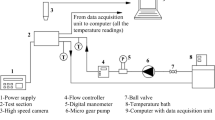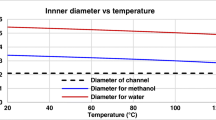Abstract
Pulsating heat pipes are a relatively newer generation of heat pipe which are wickless thus more economical and less fabrication-intensive. These devices are made of a capillary sized tube bent in a serpentine form to result in a closed system. In this study a single closed loop pulsating heat pipe made of 2 mm internal diameter copper tubing is experimentally investigated for two different bend radii. The performance comparison is made for two fluids – methanol and water, for varying heat loads from 10 W to 100 W, with various inclinations from vertical bottom heated mode to horizontal mode, for a constant fill ratio of 60%. The sharper bend, though making the device more compact, is found to reduce the performance. One of the bend geometries is further investigated for the effect of insulation on the adiabatic sections. The insulation is found to certainly widen the heat load range though a distinct performance improvement is not found. The variation of the frequency of pressure pulsations with respect to the fluid, heat load and inclination is also studied. Additionally, one of the geometry is tested with FC 72 fluid as well to arrive at a correlation for heat flux for varying fluids, heat fluxes and inclinations, covering 116 data points. The performance trends predicted by the correlation are in line with those reported in the literature.

































Similar content being viewed by others
Abbreviations
- A :
-
Area, mm2
- Bo:
-
Bond number
- C :
-
Specific heat capacity, J/kg-°C
- d :
-
Inner diameter of the tube, mm
- D :
-
Outer diameter of the tube, mm
- E :
-
Voltage, V
- Fr:
-
Froude number
- h :
-
Enthalpy, J/kg
- I :
-
Current, A
- Ja:
-
Jakob number
- Ku:
-
Kutateladze number
- L :
-
Length of the section, mm
- m :
-
Number of trials
- Mo:
-
Morton number
- n :
-
Number of samples over a minute
- P :
-
Pressure, Pa
- Pr:
-
Prandtl number
- \( \dot{Q} \) :
-
Heat load, W
- \( \dot{q} \) :
-
Heat flux, W/m2
- r :
-
Resistance, °C/W
- R :
-
Radius of the bend, mm
- Re:
-
Reynolds number
- T :
-
Temperature, °C
- V :
-
Volume, ml
- We:
-
Weber number
- a :
-
Adiabatic section
- avg :
-
Average
- c :
-
Condenser
- corr :
-
Correlated
- cs :
-
Cross-section area of the flow
- dry :
-
Dry (fluidless)
- e :
-
Evaporator
- eff :
-
Effective
- exp :
-
Experimental
- fg :
-
Liquid-vapour
- fill :
-
Fill ratio
- h :
-
Horizontal
- htc :
-
Heat transfer portion of condenser
- hte :
-
Heat transfer portion of evaporator
- i :
-
Number of sample
- int :
-
Internal
- k :
-
Location of temperature measurement
- L :
-
Left
- l :
-
Liquid
- max :
-
maximum
- R :
-
Right
- sat :
-
Saturation condition
- sc :
-
Surface area in condenser
- se :
-
Surface area in evaporator
- th :
-
Thermal
- trans :
-
Transducer
- v :
-
Vapour
- val:
-
Valve
- vc:
-
Straight portion of condenser
- ve:
-
Straight portion of evaporator
- β :
-
Angle of inclination from horizontal, degree
- Δ :
-
Difference
- μ :
-
Dynamic viscosity, Ns/m2
- ρ :
-
Density, kg/m3
- σ :
-
Surface tension, N/m
References
Akachi H (1990) Structure of a heat pipe. 4921041 United States, May 1, 1990
Khandekar S, Dollinger N, Groll M s.l. : Elsevier(2003) Understanding operational regimes of closed loop pulsating heat pipes: an experimental study. Appl Therm Eng 23:202–219
Zhang Y, Faghri A s.l. : Taylor and Francis(2008) Advances and unsolved issues in pulsating heat pipes. Heat Transfer Engineering 29:20–44
Khandekar S, Groll M s.l. : Elsevier(2004) An insight into thermo-hydrodynamic coupling in closed loop pulsating heat pipes. Int J Therm Sci 43:13–20
Srikrishna P, et al. (2017) Experimental investigation of a single closed loop pulsating heat pipe. Hyderabad : s.n., 2017. 24th National and 2nd International ISHMT-ASTFE Heat and Mass Transfer Conference (IHMTC-2017)
Charoensawan P, Khandekar S, Groll M, Terdtoon P s.l. : Elsevier(2003) Closed loop pulsating heat pipes Part A: parametric experimental investigations. Appl Therm Eng 23:2009–2020
Pigott RJS (1950) Pressure losses in tubing, pipe and fittings. Transactions of the ASME 72:679–688
Yang H, Khandekar S, Groll M s.l. : Elsevier(2009) Performance characteristics of pulsating heat pipes as integral thermal spreaders. 48:815–824
Chien K, Lin Y, Chen Y, Yang K, Wang C s.l. : Elsevier(2012) A novel design of pulsating heat pipe with fewer turns applicable to all orientations. Int J Heat Mass Transf 55
Han H, Cui X, Zhu Y, Sun S s.l. : Elsevier(2014) A comparative study of the behavior of working fluids and their properties on the performance of pulsating heat pipes (PHP). Int J Therm Sci 82:138–147
Sedighi E, Amarloo A, Shafii MB s.l. : Elsevier(2018) Experimental investigation of the thermal characteristics of single-turn pulsating heat pipes with an extra branch. Int J Therm Sci 134:258–268
Yang H, Khandekar S, Groll M (2004) Operational characteristics of flat plate closed loop pulsating heat pipes. . Shanghai, China : s.n., 13th International Heat Pipe Conference
Akachi H (1993) Structure of micro-heat pipe. 5219020 United States, June 15, 1993
Wong TN, Tong BY, Lim SM, Ooi KT (1999) Theoretical modeling of pulsating heat pipe. Tokyo, Japan : s.n. Proceedings of 11th International Heat Pipe Conference. pp. 159–163
Shafii MB, Faghri A, Zhang Y s.l. : ASME(2001) Thermal modeling of unlooped and looped pulsating heat pipes. J Heat Transf 123:1159–1172
Shafii MB, Faghri A, Zhang Y s.l. : Emerald Insight(2002) Analysis of heat transfer in unlooped and looped pulsating heat pipes. Int J Numer Method H Fluid Flow 12:585–609
Holley B, Faghri A s.l. : Elsevier(2005) Analysis of pulsating heat pipe with capillary wick and varying channel diameter. Int J Heat Mass Transf 48:2635–2651
Nikolayev VS (2011) A dynamic film model of the pulsating heat pipe. . s.l. : ASME. J Heat Transf 133:081504–0811-9
Khandekar S, Groll M (2008) Kuala Lumpur roadmap to realistic modelling of closed loop pulsating heat pipes. s.n., 9th International Heat pipe Symposium
Khandekar S, Charoensawan P, Groll M, Terdtoon P (2003) Closed loop pulsating heat pipes Part B: visualization and semi-empirical modeling. s.l. : Elsevier. Appl Therm Eng 23:2021–2033
Khandekar S, Groll M (2003) Pulsating heat pipes: Progress and prospects. International conference on Energy and Environment. pp. 723–730
Khandekar S, Groll M (2003) On the definition of pulsating heat pipes: An overview. : Minsk: s.n., 2003. International seminar (heat pipes, heat pumps and refrigerators)
Mameli M, Marengo M, Khandekar S s.l. : Elsevier(2014) Local heat transfer measurement and thermo-fluid characterization of a pulsating heat pipe. Int J Therm Sci 75:140–152
Khandekar S, Gautam AP, Sharma PK s.l. : Elsevier(2009) Multiple quasi-steady states in a closed loop pulsating heat pipe. Int J Therm Sci 48:535–546
Khandekar S, Groll M, Charoensawan P, Rittidech S, Terdtoon P (2004) Closed and open loop pulsating heat pipes. Shanghai : s.n., 13th International Heat Pipe Conference (13th IHPC)
Saha N, Das PK, Sharma PK s.l. : Elsevier(2014) Influence of process variables on the hydrodynamics and performance of a single loop pulsating heat pipe. Int J Heat Mass Transf 74:238–250
Khandekar S (2004) Thermo-hydrodynamics of closed loop pulsating heat pipes. University of Stuttgart.. Doctoral dissertation
Furukawa M s.l.: The Japan Society for Aeronautical and Space Sciences(2008) Fluid property equations as data base for thermal design calculations. Trans Japan Soc Aeronautical Space Sci 51:203–20\
Soponpongpipat PS, Kammuang-Lue N, Terdtoon P s.l. : Taylor and Francis(2009) Investigation of the start-up condition of a closed loop oscillating heat pipe. Heat Transfer Engineering 30:626–642
Ilinca A, Mangini D, Mameli M, Fioriti D, Filippeschi S, Araneo L, Roth N, Marengo M s.l. : IOP Publishing(2017) Fluid-flow pressure measurements and thermo-fluid characterization of a single loop two-phase passive heat transfer device. J Phys Conf Ser 923
Rittidech S, Terdtoon P, Murakami M, Kamonpet P, Jompakdee W s.l. : Elsevier(2003) Correlation to predict heat transfer characteristics of a closed-end oscillating heat pipe at normal operating condition. Appl Therm Eng 23:497–510
Shafii MB, Arabnejad S, Saboohi Y, Jamshidi H s.l. : Taylor and Francis(2010) Experimental investigation of pulsating heat pipes and a proposed correlation. Heat Transfer Engineering 31(10):854–861
Qu J, Wang Q s.l. : Elsevier(2013) Experimental study on the thermal performance of vertical closed-loop oscillating heat pipes and correlation modeling. Appl Energy 112:1154–1160
Katpradit T, Wongratanaphisan T, Terdtoon P, Kamonpet P, Polchai A, Akbarzadeh A s.l. : Elsevier(2005) Correlation to predict heat transfer characteristics of a closed end oscillating heat pipe at critical state. Appl Therm Eng 25:2138–2151
Rittidech S, Pipatpaiboon N, Terdtoon P s.l. : Elsevier(2007) Heat transfer characteristics of a closed-loop oscillating heat-pipe with check valves. Appl Energy 84:565–577
Kammuang-Lue N, Sakulchangsatjatai P, Terdtoon P, Mook DJ s.l. : Taylor and Francis(2010) Correlation to predict the maximum heat flux of a vertical closed-loop pulsating heat pipe. Heat transfer engineering 30(12):961–972
Dehshali ME, Nazari MA, Shafii MB s.l. : Elsevier(2018) Thermal performance of rotating closed-loop pulsating heat pipes: Experimental investigation and semi-empirical correlation. Int J Therm Sci 123:14–26
Author information
Authors and Affiliations
Corresponding author
Ethics declarations
All authors certify that they have no affiliations with or involvement in any organization or entity with any financial interest or non-financial interest in the subject matter or materials discussed in this manuscript.
Additional information
Publisher’s note
Springer Nature remains neutral with regard to jurisdictional claims in published maps and institutional affiliations.
Rights and permissions
About this article
Cite this article
Parthasarathi, S., Nagarajan, S., Desai, S. et al. Effect of bend radius and insulation on adiabatic section on the performance of a single closed loop pulsating heat pipe: experimental study and heat transfer correlation. Heat Mass Transfer 57, 1871–1892 (2021). https://doi.org/10.1007/s00231-021-03085-y
Received:
Accepted:
Published:
Issue Date:
DOI: https://doi.org/10.1007/s00231-021-03085-y




